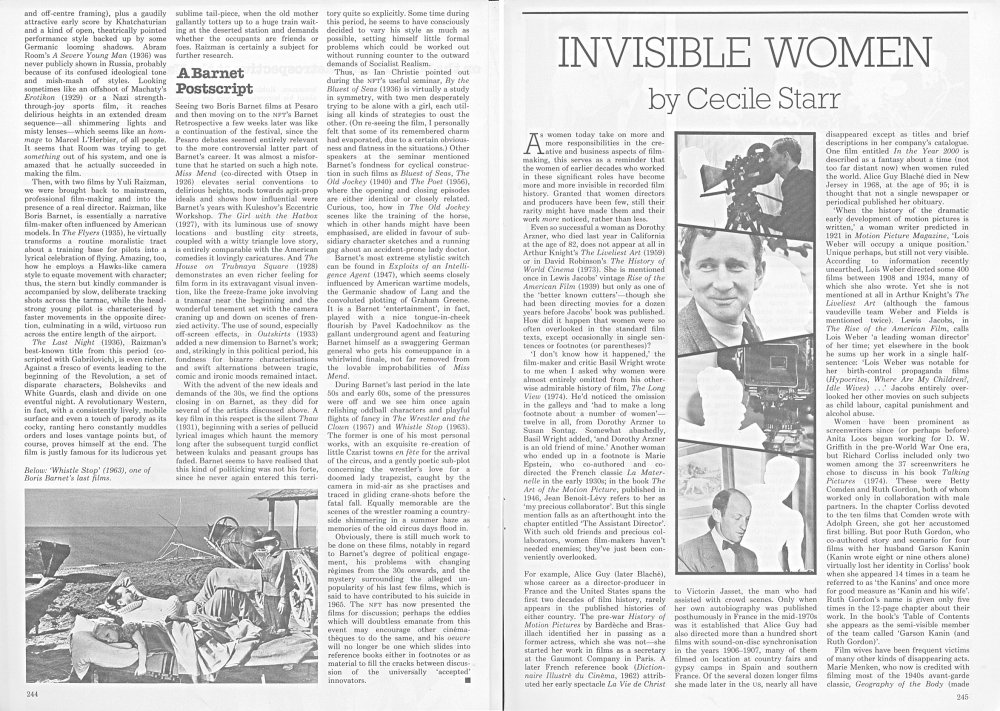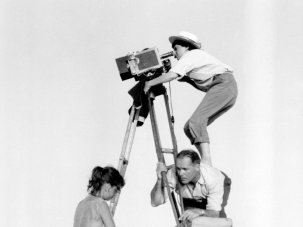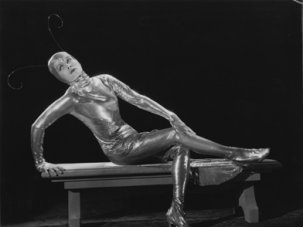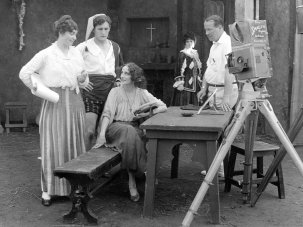As women today take on more and more responsibilities in the creative and business aspects of filmmaking, this serves as a reminder that the women of earlier decades who worked in these significant roles have become more and more invisible in recorded film history. Granted that women directors and producers have been few, still their rarity might have made them and their work more noticed, rather than less.
Even so successful a woman as Dorothy Arzner, who died last year in California at the age of 82, does not appear at all in Arthur Knight’s The Liveliest Art (1959) or in David Robinson’s The History of World Cinema (1973). She is mentioned once in Lewis Jacobs’ vintage Rise of the American Film (1939) but only as one of the “better known cutters” – though she had been directing movies for a dozen years before Jacobs’ book was published. How did it happen that women were so often overlooked in the standard film texts, except occasionally in single sentences or footnotes (or parentheses)?
“I don’t know how it happened,” the filmmaker and critic Basil Wright wrote to me when I asked why women were almost entirely omitted from his otherwise admirable history of film, The Long View (1974). He’d noticed the omission in the galleys and “had to make a long footnote about a number of women” – 12 in all, from Dorothy Arzner to Susan Sontag. Somewhat abashedly, Basil Wright added, “and Dorothy Arzner is an old friend of mine.”
Another woman who ended up in a footnote is Marie Epstein, who co-authored and co-directed the French classic La Maternelle in the early 1930s; in the book The Art of the Motion Picture, published in 1946, Jean Benoit-Levy refers to her as “my precious collaborator”. But this single mention falls as an afterthought into the chapter entitled The Assistant Director. With such old friends and precious collaborators, women filmmakers haven’t needed enemies; they’ve just been conveniently overlooked.
For example, Alice Guy (later Blaché), whose career as a director-producer in France and the United States spans the first two decades of film history, rarely appears in the published histories of either country. The pre-war History of Motion Pictures by Bardeche and Brasillach identified her in passing as a former actress, which she was not – she started her work in films as a secretary at the Gaumont Company in Paris. A later French reference book (Dictionnaire Illustre du Cinema, 1962) attributed her early spectacle La Vie de Christ to Victorin Jasset, the man who had assisted with crowd scenes.
Only when her own autobiography was published posthumously in France in the mid-1970s was it established that Alice Guy had also directed more than a hundred short films with sound-on-disc synchronisation in the years 1906-07, many of them filmed on location at country fairs and gypsy camps in Spain and southern France. Of the several dozen longer films she made later in the US, nearly all have disappeared except as titles and brief descriptions in her company’s catalogue. One film entitled In the Year 2000 is described as a fantasy about a time (not too far distant now) when women ruled the world. Alice Guy-Blaché died in New Jersey in 1968, at the age of 95; it is thought that not a single newspaper or periodical published her obituary.
“When the history of the dramatic early development of motion pictures is written,” a woman writer predicted in 1921 in Motion Picture Magazine, “Lois Weber will occupy a unique position.” Unique perhaps, but still not very visible. According to information recently unearthed, Lois Weber directed some 400 films between 1908 and 1934, many of which she also wrote. Yet she is not mentioned at all in Arthur Knight’s The Liveliest Art (although the famous vaudeville team Weber and Fields is mentioned twice). Lewis Jacobs, in The Rise of the American Film, calls Lois Weber “a leading woman director” of her time; yet elsewhere in the book he sums up her work in a single half-sentence: “Lois Weber was notable for her birth-control propaganda films (The Hypocrites, Where Are My Children?, Idle Wives)…” Jacobs entirely overlooked her other movies on such subjects as child labour, capital punishment and alcohol abuse.
Women have been prominent as screenwriters since (or perhaps before) Anita Loos began working for D.W. Griffith in the pre-World War I era, but Richard Corliss included only two women among the 37 screenwriters he chose to discuss in his book Talking Pictures (1974). These were Betty Comden and Ruth Gordon, both of whom worked only in collaboration with male partners. In the chapter Corliss devoted to the ten films that Comden wrote with Adolph Green, she got her accustomed first billing. But poor Ruth Gordon, who co-authored story and scenario for four films with her husband Garson Kanin (Kanin wrote eight or nine others alone) virtually lost her identity in Corliss’s book when she appeared 14 times in a team he referred to as “the Kanins” and once more for good measure as “Kanin and his wife”. Ruth Gordon’s name is given only five times in the 12-page chapter about their work. In the book’s Table of Contents she appears as the semi-visible member of the team called “Garson Kanin (and Ruth Gordon)”.
Film wives have been frequent victims of many other kinds of disappearing acts. Marie Menken, who now is credited with filming most of the 1940s avant-garde classic Geography of the Body (made with her husband, the poet Willard Maas), received no screen mention for her work – although the film depended heavily on its effective photography of his and her bodies. And while much has been written about Maya Deren, the “mother of the American avant-garde film”, a recent trend seems to attribute much of her best film, Meshes of the Afternoon (1943), to the talents of her collaborator (then her husband), Alexander Hammid. But most filmmakers choose collaborators of similar or comparable abilities; film history and responsible criticism should be able to accommodate both its Derens and its Hammids, for their diverse talents, without pitting partner against partner.
I must add that until the 1970s women’s movement focused attention on women’s creative achievements, I sometimes neglected to include my friend Claire Parker as full collaborator with her husband Alexander Alexieff on their pinboard animation films, although Alexieff’s writings and the films’ screen credits give her full recognition for her work. But a recent Italian book on animation entitled Topolino e Poi (by G. Bendazzi, 1977) ignores her even more baldly. A photograph in the book shows her peering over Alexieff’s shoulder; the caption reads only “Alexandre Alexieff”.
Ruth Orkin, who received screen credit as co-director of The Little Fugitive and Lovers and Lollipops in the 1950s with her husband Morris Engel, was also rendered distinctly invisible, in a photograph illustrating Edward Fischer’s article, Men Behind the Movies (the National Observer, 1964). The portrait of this adventurous young filmmaking couple bears this caption: “Mr Engel: from a small budget – art.”
Ruth Orkin has been further overlooked by a long list of distinguished writers that includes Saul Bellow, François Truffaut, Harris Dienstfrey and Jonas Mekas. “What we now call the New Wave originated with Morris Engel,” Saul Bellow wrote in Horizon Magazine (1959), after conducting an interview in the couple’s apartment at which Orkin perhaps acted as the coffee server. In a New Yorker interview (1960) Truffaut is quoted: “Our new wave would never have come into being if it hadn’t been for the young American Morris Engel, who showed us the way – with his fine movie, Little Fugitive.” Dienstfrey wrote in Commentary (June 1962) that Morris Engel was the New American Cinema’s “foremost pioneer”. (Not long ago Ruth Orkin spoke with Dienstfrey, who seemed “genuinely surprised when I informed him that Morris Engel didn’t make his first two films all alone.”) However, Engel was solely responsible for two later films, which were less favourably received.
Jonas Mekas, in an article entitled The Changing Language of Cinema (first published in the Village Voice in 1962) wrote that the change to a freer, independent cinema in the us “began with In the Street, with James Agee, with Sidney Meyers, with Morris Engel, with Stanley Brakhage.” Mekas omitted not only Ruth Orkin but also Helen Levitt, who had filmed most of the short documentary In the Street, and had also urged her friends Janice Loeb and James Agee to try their hands behind the camera. Mekas’s all-male list of notable independent filmmakers reappears in his own book of collected writings Movie Journal (1972), and in P. Adams Sitney’s Visionary Cinema (1974), and continues to be quoted and paraphrased elsewhere. Daryl Chin, in an article on Francis Lee (the Soho Weekly News, 1976) included Loeb and Agee in his mention of In the Street but inverted the credits to put Agee first and Levitt last. This is not at all uncommon, since Agee has become a cult figure in both film and literary circles. Fortunately, both Ruth Orkin and Helen Levitt have been much more widely recognised for their work as still photographers.
Another successful still photographer, Erica Anderson, got screen credit for filming Grandma Moses in 1950, with Jerome Hill listed as director – although he was not present when the film was shot. Their later productions, including the feature-length Academy Award winner Albert Schweitzer (1955), credit Anderson as director and Hill as producer. You will look long and hard to find Erica Anderson mentioned in books about American documentary filmmaking, although she is said to have been the first person in the us to shoot low-budget independent art documentaries on 16mm.
Helen Grayson, the first American woman to launch a full-fledged career as a documentary director, got off to a good start in film history but ended up as another invisible woman. Her work merited a full page in Documentary Film (1952) by Paul Rotha and Richard Griffith, in which Griffith called her first film, The Cummington Story, one of the best government wartime productions. But two decades later, Richard Barsam in The Non-Fiction Film (1973) incorrectly listed Sidney Meyers as the film’s producer, editor and narrator (to my knowledge he had been only its editor) and didn’t mention Helen Grayson at all. Nor did Lewis Jacobs mention her in his listing of the film in The Documentary Tradition (1974).
While Esther Shub is written about in many books on Russian film as the creator of the first compilation movies – i.e. artistically new films created from old footage – her name is conspicuously missing from the major writings of Sergei Eisenstein, although it is generally agreed that Eisenstein learned from her the technical realities of montage which became the keystone of his first great films. The oversight seems to have carried over into real life, according to a recent book on Eisenstein by F. Room, who states that Shub never understood why she alone of Eisenstein’s early film colleagues was not asked by him to work on his first big production, Strike (1924).
Women filmmakers are frequently overlooked or slighted in the important collections and film programmes on which motion picture history so often is based. For example, a three-year Sunday evening series entitled History of Film, at the Museum of Modern Art in New York, ended last spring after having projected some 300 hours of films from the Museum’s archives, of which only some three hours were made predominantly by women. Although this series included many avant-garde films of the 1970s, the most recent women’s film shown was Shirley Clarke’s four-minute Bridges-go-Round, dating from 1958. A later four-week exhibition called American Independent Cinema: Recent Acquisitions included three films made by women, in a total of over 50 titles.
The British-born writer Iris Barry, though not a filmmaker, surely deserves permanent recognition in American film history as the one person who more than any other influenced research and study in film. As the Museum of Modern Art’s first and most farsighted film curator, she substantially established the framework on which its archives, circulating film library and publications are still based. Yet her name cannot be found in current film histories written by a generation of specialists schooled in the very films that Iris Barry preserved for them. The Museum itself doesn’t mention her name in its current film catalogue, nor is there any visible tribute to her work in the Museum proper*. In his historical retrospective article MOMA and the Movies (ARTnews, October 1979), Andrew Sarris referred to himself more than a dozen times (as “I” or “my”), although he had little to do with the Museum’s film activities. Iris Barry’s name appeared only twice.
While cults have grown up round many types of motion pictures – from westerns to musical comedies to horror movies – ‘women’s pictures’ have usually been referred to within quotation marks and have been treated with relative disdain. Films that see life from a woman’s viewpoint have neither been absorbed into the mainstream of standard film history, nor have they received special recognition outside.
Sarris, for example, in an article entitled The Ladies Auxiliary, 1976 (published in the recent anthology Women and the Cinema), states his preferences for women-oriented movies made by such directors as Lubitsch, Minnelli and Sirk, over those made by Ida Lupino and Dorothy Arzner. Sarris objected to Ida Lupino as a director on the grounds that her leading ladies looked too much like herself. Arzner’s “only ideological edge” over prominent male directors of women-oriented movies “may turn out to be the spectacular spinelessness of her male characters”. Sarris concludes, however, that Dorothy Arzner has risen “from a mere footnote” to “a chapter heading all her own.” Where this chapter has appeared, or will, he did not state.
No one seems to know how all this has happened, any more than Basil Wright did. Such consistent neglect seems to have been largely unintentional, if not unconscious; yet inestimable damage and hurt must have been done to the women filmmakers of the past. Would Dorothy Arzner or Helen Grayson or Ruth Orkin have stopped making movies in mid-life, if they had been given the kinds of recognition their male counterparts received? With footnotes, parentheses, half-sentences, or no mention at all, many talented, hard-working women of the past have become virtually invisible in recorded film history. Does this mean that women who are now making films are already fading into oblivion, like smiling Cheshire cats, before our very eyes?
* A recent low-key tribute to Iris Barry, in connection with the Museum’s 50th anniversary, was so small and unceremonious that it went unnoticed by all but a handful of her former colleagues and friends. But a handsome commemorative publication, Remembering Iris Barry, supplied brief tributes and recollections by 11 of them.
-
Women on Film – all our coverage

A window on our ongoing coverage of women’s cinema, from movies by or about women to reports and comment on the underrepresentation of women...
-
The Digital Edition and Archive quick link
Log in here to your digital edition and archive subscription, take a look at the packages on offer and buy a subscription.











